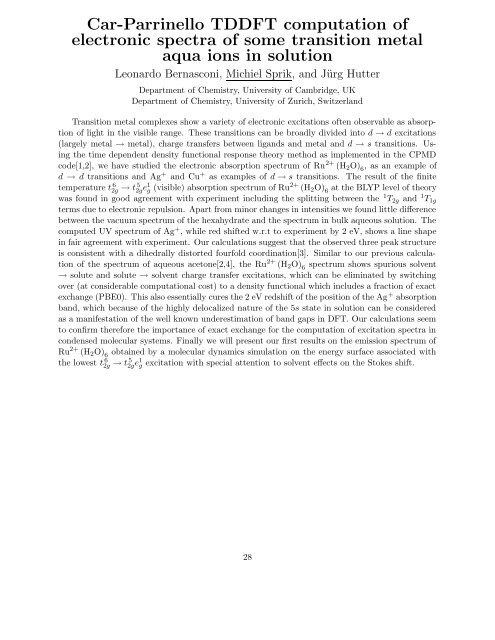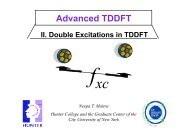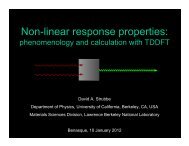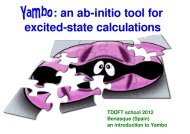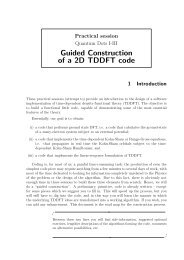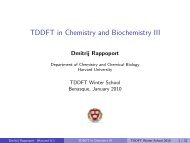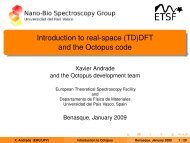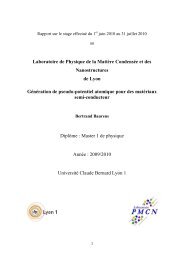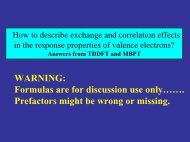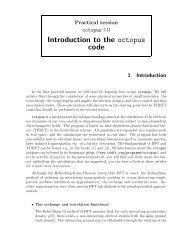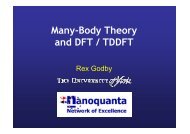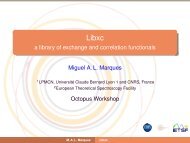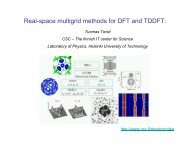TIME DEPENDENT DENSITY FUNCTIONAL THEORY ... - TDDFT.org
TIME DEPENDENT DENSITY FUNCTIONAL THEORY ... - TDDFT.org
TIME DEPENDENT DENSITY FUNCTIONAL THEORY ... - TDDFT.org
- No tags were found...
Create successful ePaper yourself
Turn your PDF publications into a flip-book with our unique Google optimized e-Paper software.
Car-Parrinello <strong>TDDFT</strong> computation of<br />
electronic spectra of some transition metal<br />
aqua ions in solution<br />
Leonardo Bernasconi, Michiel Sprik, and Jürg Hutter<br />
Department of Chemistry, University of Cambridge, UK<br />
Department of Chemistry, University of Zurich, Switzerland<br />
Transition metal complexes show a variety of electronic excitations often observable as absorption<br />
of light in the visible range. These transitions can be broadly divided into d → d excitations<br />
(largely metal → metal), charge transfers between ligands and metal and d → s transitions. Using<br />
the time dependent density functional response theory method as implemented in the CPMD<br />
code[1,2], we have studied the electronic absorption spectrum of Ru 2+ (H 2 O) 6 , as an example of<br />
d → d transitions and Ag + and Cu + as examples of d → s transitions. The result of the finite<br />
temperature t 6 2g → t 5 2g e1 g (visible) absorption spectrum of Ru2+ (H 2 O) 6<br />
at the BLYP level of theory<br />
was found in good agreement with experiment including the splitting between the 1 T 2g and 1 T 1g<br />
terms due to electronic repulsion. Apart from minor changes in intensities we found little difference<br />
between the vacuum spectrum of the hexahydrate and the spectrum in bulk aqueous solution. The<br />
computed UV spectrum of Ag + , while red shifted w.r.t to experiment by 2 eV, shows a line shape<br />
in fair agreement with experiment. Our calculations suggest that the observed three peak structure<br />
is consistent with a dihedrally distorted fourfold coordination[3]. Similar to our previous calculation<br />
of the spectrum of aqueous acetone[2,4], the Ru 2+ (H 2 O) 6<br />
spectrum shows spurious solvent<br />
→ solute and solute → solvent charge transfer excitations, which can be eliminated by switching<br />
over (at considerable computational cost) to a density functional which includes a fraction of exact<br />
exchange (PBE0). This also essentially cures the 2 eV redshift of the position of the Ag + absorption<br />
band, which because of the highly delocalized nature of the 5s state in solution can be considered<br />
as a manifestation of the well known underestimation of band gaps in DFT. Our calculations seem<br />
to confirm therefore the importance of exact exchange for the computation of excitation spectra in<br />
condensed molecular systems. Finally we will present our first results on the emission spectrum of<br />
Ru 2+ (H 2 O) 6<br />
obtained by a molecular dynamics simulation on the energy surface associated with<br />
the lowest t 6 2g → t 5 2g e1 g excitation with special attention to solvent effects on the Stokes shift.<br />
28


